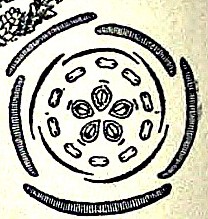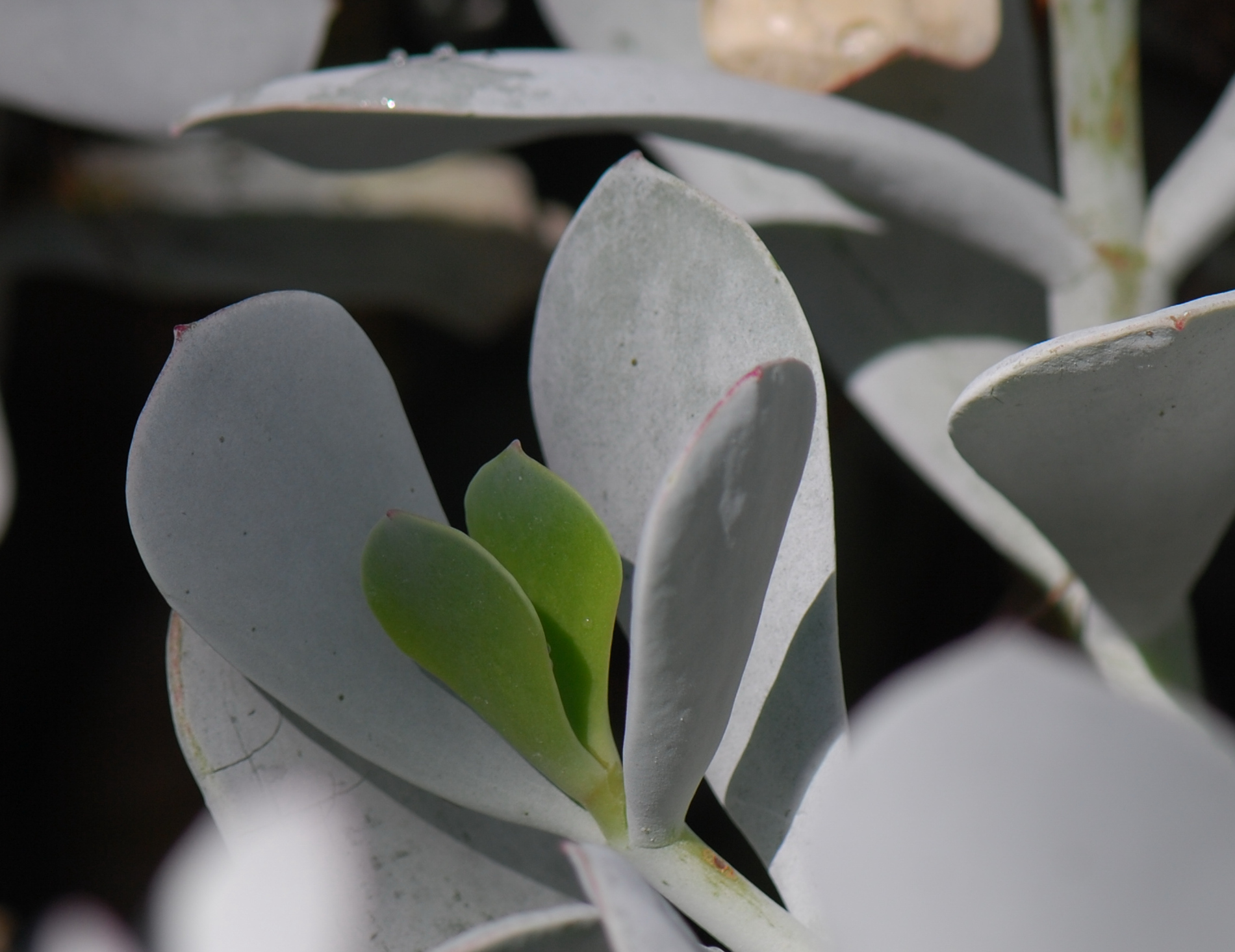|
Crassulaceae
The Crassulaceae (from Latin ''crassus'', thick), also known as the stonecrop family or the orpine family, are a diverse family of dicotyledon flowering plants characterized by succulent leaves and a unique form of photosynthesis, known as Crassulacean acid metabolism (CAM). Flowers generally have five floral parts. Crassulaceae are usually herbaceous but there are some subshrubs, and relatively few treelike or aquatic plants. Crassulaceae are a medium size monophyletic family in the core eudicots, among the order Saxifragales, whose diversity has made infrafamilial classification very difficult. The family includes approximately 1,400 species and 34–35 genera, depending on the circumscription of the genus '' Sedum'', and distributed over three subfamilies. Members of the Crassulaceae are found worldwide, but mostly in the Northern Hemisphere and southern Africa, typically in dry and/or cold areas where water may be scarce, although a few are aquatic. Crassulaceae are m ... [...More Info...] [...Related Items...] OR: [Wikipedia] [Google] [Baidu] |
Sedum
''Sedum'' is a large genus of flowering plants in the family Crassulaceae, members of which are commonly known as stonecrops. The genus has been described as containing up to 600 species, subsequently reduced to 400–500. They are leaf succulents found primarily in the Northern Hemisphere, but extending into the southern hemisphere in Africa and South America. The plants vary from annual and creeping herbs to shrubs. The plants have water-storing leaves. The flowers usually have five petals, seldom four or six. There are typically twice as many stamens as petals. Various species formerly classified as ''Sedum'' are now in the segregate genera ''Hylotelephium'' and '' Rhodiola''. Well-known European species of ''Sedum'' are '' Sedum acre'', '' Sedum album'', ''Sedum dasyphyllum'', ''Sedum reflexum'' (also known as ''Sedum rupestre'') and '' Sedum hispanicum''. Description ''Sedum'' is a genus that includes annual, biennial, and perennial herbs. They are characterised b ... [...More Info...] [...Related Items...] OR: [Wikipedia] [Google] [Baidu] |
Sempervivoideae
Sempervivoideae is the largest of three subfamilies in the Saxifragales family Crassulaceae, with about 20–30 genera with succulent leaves. Unlike the two smaller subfamilies, it is distributed in temperate climates. The largest genus in this subfamily is ''Sedum'', with about 470 species. Description Succulent leaved plants. Unlike the other two smaller subfamilies, which are highly derived, Sempervivoideae retain the basic features of the family Crassulaceae. The Sempervivoideae contain many familiar horticultural plants, such as ''Sedum''. Taxonomy Sempervivoideae has taxonomic priority over its synonym, Sedoideae, and is related to the other Crassulaceae subfamilies, as shown in this cladogram, although Messerschmid and colleagues (2020) state that these three subfamily clades are successive sisters, rather than Sempervivoideae being a direct sister only to Kalanchoideae. Subdivisions Six clades within Sempervivoideae have been segregated into five tribes wi ... [...More Info...] [...Related Items...] OR: [Wikipedia] [Google] [Baidu] |
Saxifragales
The Saxifragales (saxifrages) are an order of flowering plants (Angiosperms). They are an extremely diverse group of plants which include trees, shrubs, perennial herbs, succulent and aquatic plants. The degree of diversity in terms of vegetative and floral features makes it difficult to define common features that unify the order. In the Angiosperm Phylogeny Group classification system, the Saxifragales are placed within the major division of flowering plants referred to as eudicots, specifically the core eudicots. This subgroup consists of the Dilleniaceae, superasterids and superrosids. The superrosids in turn have two components, rosids and Saxifragales. The Saxifragales order has undergone considerable revision since its original classification based purely on plant characteristics. The modern classification is based on genetic studies using molecular phylogenetics. There is an extensive fossil record from the Turonian- Campanian (late Cretaceous) time, about ... [...More Info...] [...Related Items...] OR: [Wikipedia] [Google] [Baidu] |
Bryophyllum
''Bryophyllum'' (from the Greek ''bryon/bryein'' = sprout, ''phyllon'' = leaf) is a group of plant species of the family Crassulaceae native to Madagascar. It is a section or subgenus within the genus '' Kalanchoe'', and was formerly placed at the level of genus. This section is notable for vegetatively growing small plantlets on the fringes of the leaves; these eventually drop off and root. These plantlets arise from mitosis of meristematic-type tissue in notches in the leaves. Nowadays, bryophyllums are naturalized in many parts of the tropics and subtropics, and deliberately cultivated for their attractiveness or for their interesting reproduction as a vegetative reproductive plant. Taxonomy Species of ''Bryophyllum'' are nested within '' Kalanchoe'' on molecular phylogenetic analysis. Therefore, ''Bryophyllum'' should be a section of ''Kalanchoe'' rather than a separate genus. The number of species within ''Bryophyllum'' varies with definitions of this section. '' ... [...More Info...] [...Related Items...] OR: [Wikipedia] [Google] [Baidu] |
Kalanchoideae
''Kalanchoideae'' is one of three subfamilies in the Saxifragales family Crassulaceae, with four succulent genera. Genera The following five genera are recognised: *'' Adromischus'' *''Cotyledon'' *''Kalanchoe ''Kalanchoe'' , also written ''Kalanchöe'' or ''Kalanchoë'', is a genus of about 125 species of tropical, succulent plants in the stonecrop family Crassulaceae, mainly native to Madagascar and tropical Africa. A ''Kalanchoe'' species was one ...'' *'' Tylecodon'' Taxonomy References External linksKalanchoideae on species.wikimedia.org {{Taxonbar, from=Q3192106 Crassulaceae Succulent plants [...More Info...] [...Related Items...] OR: [Wikipedia] [Google] [Baidu] |
Crassula
''Crassula'' is a genus of succulent plants containing about 200 accepted species, including the popular jade plant (''Crassula ovata''). They are members of the stonecrop family (Crassulaceae) and are native to many parts of the globe, but cultivated varieties originate almost exclusively from species from the Eastern Cape of South Africa. Crassulas are usually propagated by stem or leaf cuttings. Most cultivated forms will tolerate some small degree of frost, but extremes of cold or heat will cause them to lose foliage and die. Taxonomy ''Crassula'' was first formally described by Carl Linnaeus in 1753 with 10 species. Etymology The name crassula comes from the Latin adjective ''crassus'', meaning thick, referring to the thickening of the succulent leaves. List of selected species *''Crassula alata'' *'' Crassula alba'' *'' Crassula alpestris'' (Sand-Coated Crassula) *''Crassula alstonii'' *''Crassula aquatica'' (common pigmyweed, water pygmyweed) *'' Crassula arbore ... [...More Info...] [...Related Items...] OR: [Wikipedia] [Google] [Baidu] |
Succulent
In botany, succulent plants, also known as succulents, are plants with parts that are thickened, fleshy, and engorged, usually to retain water in arid climates or soil conditions. The word ''succulent'' comes from the Latin word ''sucus'', meaning "juice" or "sap". Succulent plants may store water in various structures, such as leaves and stems. The water content of some succulent organs can get up to 90–95%, such as ''Glottiphyllum semicyllindricum'' and ''Mesembryanthemum barkleyii''. Some definitions also include roots, thus geophytes that survive unfavorable periods by dying back to underground storage organs may be regarded as succulents. The habitats of these water-preserving plants are often in areas with high temperatures and low rainfall, such as deserts, but succulents may be found even in alpine ecosystems growing in rocky soil. Succulents are characterized by their ability to thrive on limited water sources, such as mist and dew, which makes them equipped t ... [...More Info...] [...Related Items...] OR: [Wikipedia] [Google] [Baidu] |
Crassulacean Acid Metabolism
Crassulacean acid metabolism, also known as CAM photosynthesis, is a carbon fixation pathway that evolved in some plants as an adaptation to arid conditions that allows a plant to photosynthesize during the day, but only exchange gases at night. In a plant using full CAM, the stomata in the leaves remain shut during the day to reduce evapotranspiration, but they open at night to collect carbon dioxide () and allow it to diffuse into the mesophyll cells. The is stored as four-carbon malic acid in vacuoles at night, and then in the daytime, the malate is transported to chloroplasts where it is converted back to , which is then used during photosynthesis. The pre-collected is concentrated around the enzyme RuBisCO, increasing photosynthetic efficiency. This mechanism of acid metabolism was first discovered in plants of the family Crassulaceae. Historical background Observations relating to CAM were first made by de Saussure in 1804 in his ''Recherches Chimiques sur la Végétat ... [...More Info...] [...Related Items...] OR: [Wikipedia] [Google] [Baidu] |
Cotyledon (genus)
''Cotyledon'' is one of some 35 genera of succulent plants in the family Crassulaceae. Mostly from Southern Africa, they also occur throughout the drier parts of Africa as far north as the Arabian Peninsula. Ten of its species are mostly confined to South Africa, where unlike ''Tylecodon'', they occur commonly in both the winter and summer rainfall regions. They may be found on coastal flats and rocky hillsides, or as cremnophytes on cliff faces. Their decussate, evergreen leaves are very variable in shape, even within some species, but the flowers are, apart from colour, very similar. Description Members of the genus are shrublets, generally succulent, with fleshily woody, brittle stems and persistent succulent leaves. The leaves are opposite. Leaf pairs generally are oriented at 90 degrees to their preceding and following pairs, as is common in the family Crassulaceae, but the leaf habit differs from say ''Tylecodon'' (in which the leaves are borne in spirals and are d ... [...More Info...] [...Related Items...] OR: [Wikipedia] [Google] [Baidu] |
Echeveria
''Echeveria'' is a large genus of flowering plants in the family Crassulaceae, native to semi-desert areas of Central America, Mexico and northwestern South America. Description Plants may be evergreen or deciduous. Flowers on short stalks (cymes) arise from compact rosettes of succulent fleshy, often brightly coloured leaves. Species are polycarpic, meaning that they may flower and set seed many times over the course of their lifetimes. Often numerous offsets are produced, and are commonly known as " hen and chicks", which can also refer to other genera, such as ''Sempervivum'', that are significantly different from ''Echeveria''. Many species of ''Echeveria'' serve important environmental roles, such as those of host plants for butterflies. For example, the butterfly ''Callophrys xami'' uses several species of ''Echeveria'', such as ''Echevelia gibbiflora'', for suitable host plants. Even more, these plants are integral to the oviposition process of ''C. xami'' and some oth ... [...More Info...] [...Related Items...] OR: [Wikipedia] [Google] [Baidu] |
Aeonium Arboreum
''Aeonium arboreum'', the tree aeonium, tree houseleek, or Irish rose, is a succulent, subtropical subshrub in the flowering plant family Crassulaceae. It is an invasive weed in places outside its natural distribution, for example as a garden escape throughout temperate southern Australia. Description ''Aeonium arboreum'' grows as a less branched subshrub and reaches stature heights of up to 2 metres. The more or less upright or ascending, smooth, not net-like patterned stem axes have a diameter of 1 to 3 centimetres. Their leaves are in flattened rosettes with diameters of 10 to 25 centimetres at the end of the stem axes together. Young leaves are pressed tightly together. The obovate to oblate lanceolate leaf blade is pointed toward its apex and wedge-shaped at the base. It is long, wide and 1.5 to 3 millimetres thick. The green, usually purple-colored, glossy leaf surface is almost bare. The leaf margin is set with curved eyelashes. The conical to ovate inflorescence ha ... [...More Info...] [...Related Items...] OR: [Wikipedia] [Google] [Baidu] |
Monanthes
''Monanthes'' is a genus of small, succulent, subtropical plants of the family Crassulaceae. The about ten species are mostly endemic to the Canary Islands and Savage Islands, with some found on Madeira. Its center of diversity is Tenerife, with seven species occurring on this island. On Fuerteventura and Lanzarote, only ''M. laxiflora'' occurs. ''Monanthes'' is a rare example where a species re-colonizes the continent from an island, after their ancestors have colonized the island from the continent. ''Monanthes'' are not frost-resistant. They are linked with the genera ''Sempervivum'', '' Greenovia'', ''Aichryson'' and ''Aeonium'', which is obvious from their similar flowers. Species of ''Monanthes'' differ considerably in life- and growth-form. ''M. icterica'', which is also genetically quite distant to other ''Monanthes'' species, is annual, while the other species are perennial. Taxonomy Accepted species include: * ''Monanthes anagensis'' Praeger * ''Monanthes atlantica'' ... [...More Info...] [...Related Items...] OR: [Wikipedia] [Google] [Baidu] |





_Echeveria_secunda.jpg)